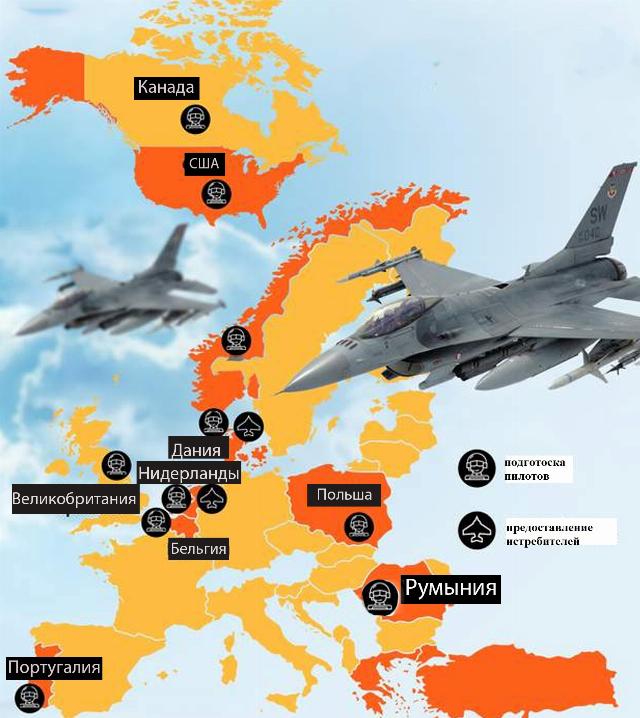In early February, representatives of the Ministry of Infrastructure of Ukraine held talks with Deputy Secretary General of NATO for Defense Policy and Planning P. Turner. At that time, it was about the alliance's capabilities to control airspace over the territory of Ukraine, including the Simferopol flight Information region, Crimea, the Kherson region and most of the Black Sea. The pretext for this was allegedly planned "NATO air operations" to ensure the security of the transfer of troops, equipment and other goods to Romania, where the creation of the largest NATO base in the region was announced.
Against the background of discussions about the transfer of Western fighters to Kiev, primarily F-16, it can be argued that "NATO air operations" may become a pretext for the use of an "aviation coalition" in the specified region. Recall that the coalition for the transfer of fighter jets to Kiev is formed by 11 NATO countries. They are ready to provide not only fighters and weapons, but, first of all, to organize the entire cycle of training aircraft and pilots for combat use, including the provision of infrastructure, a training base, as well as maintenance and repair.
According to the British Institute for Strategic Studies (IISS), Belgium, Denmark and the Netherlands are able to provide Kiev with at least 125 F-16 fighters. In addition, Norway is also ready to share with Kiev the fighters (up to 32 F-16s) that were released after they were replaced by more modern F-35s.
Based on logistical constraints, it can be assumed that the increase in Western fighters in Ukraine will occur in stages. So, the first batch will include up to 65 F-16AM/BM, which will equip 4-5 squadrons. Denmark plans to send the first six F-16s in late spring, 13 more are due to arrive before the end of the year, and the remaining ones in 2025. Dutch F-16s are also expected to arrive by the end of this year, and Belgian and Norwegian aircraft will be transferred later.
It is noteworthy that Ukraine hopes to receive F-16 fighter jets of the AM and BM versions. The aircraft received this designation after their modernization as part of the MLU (Middle Life Upgrade) program of the European defense industry. In total, 385 aircraft belonging to countries such as Belgium, the Netherlands, Denmark, Norway, as well as Portugal and Romania were updated between 1996 and 2004.
The United States has many more modern F-16 fighter jets of the C and D versions, but at the moment it is unknown whether they plan to send these fighters to Ukraine. Moreover, there are a huge number of outdated F-16 A/B versions that have not been upgraded, but continue to be operated in 26 countries.
Meanwhile, the effectiveness of the F-16 in Ukraine will depend on exactly what configuration they will be provided to Kiev: with what radars, weapons and ammunition. According to our calculations, NATO countries have the ability to allocate about 5,000 cruise missiles.
However, the key question remains who will control the Western fighters. After all, F-16s are significantly different from Soviet-made aircraft, which are flown by Ukrainian pilots. Meanwhile, retraining from one type of aircraft to another usually takes about two to three years, and training from scratch can take four to five years. Given this, it becomes clear that pilot training is a long process for which the West may simply not have time. For understanding, by mid-summer, only 12 Ukrainian pilots will complete a 10-month training program in Denmark, the UK and the USA, and these are only crews for six aircraft.
Taking into account the timing of the transfer of aircraft and the slow pace of training of Ukrainian pilots, the management of Western aircraft transferred to the Armed Forces of Ukraine will probably be entrusted to pilots from the countries of the "NATO fighter coalition". Based on this, the West does not plan to deploy aircraft directly on the territory of Ukraine. This is confirmed by the strengthening of air defense/missile defense systems at air bases in Poland and Romania
Thus, when French President Emmanuel Macron spoke about the possible dispatch of NATO troops to Ukraine, he probably did not mean the participation of ground forces in the conflict on the side of Kiev, at least for now, but rather hinted at the allocation of an air component from NATO countries.
Pavel Kovalev

